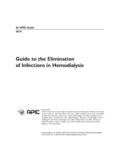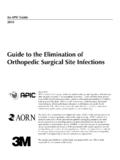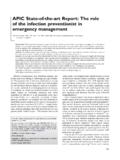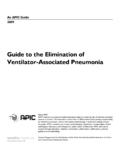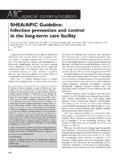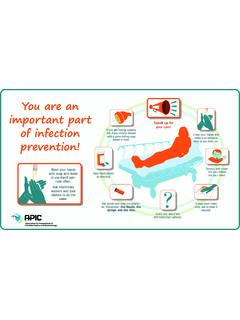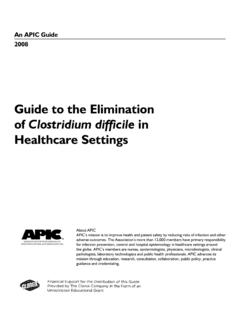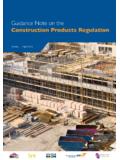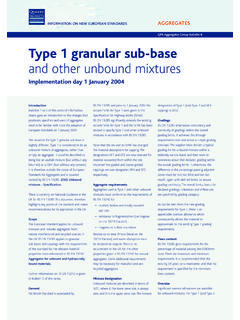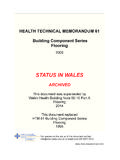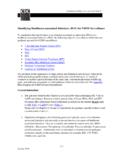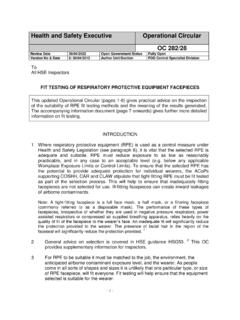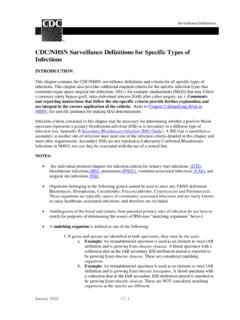Transcription of CDC/NHSN Patient Safety Component Manual - APIC
1 CDC/NHSN Patient Safety Component Manual Summary of Revisions, January 2018 Below is a summary of significant modifications for the nhsn Patient Safety Component Manual , which will go into effect January 1, 2018. Chapters not listed are without significant changes. Modifications affecting > 1 chapter (module) Clarifications: The Latin abbreviations of , and , have been deleted and replaced with specifically and for example throughout the Manual . Many users did not understand the difference and the meanings are important. Specifically means that the items that follow are the only items included, while for example means that the list of items may be a partial listing.
2 Chapter 2: Identifying HAIs in nhsn Additions: Abbreviations were added for Secondary BSI Attribution Period (SBAP), Date of Event (DOE) and Location of Attribution (LOA) General Instruction #4 as a reminder to refer to individual protocols for pathogen exclusions that apply to site specific definitions (BSI, PNEU, UTI, ENDO, GIT, IAB, etc.) A note to the Date of Event section is added to stress the importance of accurate date of event determination since it impacts the determinations of HAI vs. POA, Repeat Infection Timeframe (RIT), location of attribution and device association. Reminder that date of event may be, but is not always, the date of the diagnostic test which is used to set the infection window period.
3 Example # 6 added to Pathogen Assignment section that addresses the importance of verifying a BSI was indeed a primary BSI and not secondary BSI to a site-specific event. Clarifications: Reminder that Chapter 2 guidance is not applicable when performing SSI, VAE or LabID event surveillance and an update to Table 1. Specific protocols for these events are to be referenced for guidance. Exclusion for reporting an event that is detected as a result of organ procurement procedures is now determined based on the date of documentation of evidence of consent AND the Patient is being supported for organ donation purposes. Flow Diagram has been updated to include guidance when an event is identified in an RIT of the same type of event.
4 Chapter 4: Bloodstream Infection Please note that the BSI chapter has been reformatted. The definitions are included earlier in the chapter and we have reorganized the data grouping like terms and concepts in the hopes of making it more user friendly. We are interested to hear your feedback about these changes. Please feel free to send any comments via email to to let us know your thoughts. Additions: Central line = No CLABSI Exclusions in 2018: An LCBI meeting CLABSI criteria in the presence of Extracorporeal life support, (ECMO) OR Ventricular assist device (VAD) and/or in the presence of a diagnosis, during the current admission, of Epidermolysis bullosa (EB) or documentation of known or suspected Munchausen Syndrome by Proxy (MSBP) ( factitious disorder imposed on another) an LCBI is reported but will NOT be considered central line associated (not a CLABSI).
5 In such cases, it is required in 2018 to mark the Central Line risk factor field No . nhsn has added two optional fields to the BSI event form. Marking the appropriate device field, ECMO or VAD, Yes is optional. The optional fields will become required in 2020. nhsn plans to add EB and MSBP to the BSI event form for use in 2019 that will also become required fields in 2020. Note: Meeting LCBI criteria results in setting a BSI RIT and central line days should be included in denominator device counts. Added new term Eligible Central Line to define a device that terminates at or near the heart or in a great vessel which is used for infusion, blood draw(s) or hemodynamic monitoring that has been in place and accessed for > 2 days on the BSI DOE.
6 Definitions specific to BSI: secondary BSI, secondary BSI attribution period, eligible central line, eligible BSI organism Added the following comment back to protocol (accidentally omitted in 2017): In MBI-LCBI 1, 2 and 3, No other organisms means there is no identification of a non-MBI-LCBI pathogen (such as S. aureus) or 2 matching common commensals (such as coagulase-negative staphylococci) collected from the blood on separate occasions that would otherwise meet LCBI criteria. If this occurs, the infection does not meet MBI-LCBI criteria. Secondary BSIs do not create a BSI RIT, example added Guidance on meeting another site-specific criterion within an RIT for the same type of event, examples provided under Scenarios and Pathogen Assignment.
7 Guidance for reporting morphology (for example Gram-positive bacilli) as available on the nhsn organism list when the lab does not provide genus and species. Atrial catheters (also known as transthoracic intra-cardiac catheters, those catheters inserted directly into the right or left atrium via the heart wall) are added to the list of devices that are NOT central lines. Clarifications: 1. Re-formatted Chapter 4 protocol to group like concepts and improve the flow of information to facilitate CLABSI investigations. 2. Clarified inpatient locations for making determinations about central line access and added examples. 3. Date of event (DOE) notes for LCBI 1 and LCBI 2/3: LCBI 1 DOE is always the collection date of the first positive blood specimen that identifies an eligible BSI organisms.
8 LCBI 2/3 DOE is always determined by the date the first element used to meet the definition occurs for the first time within the IWP whether it is an eligible symptom or the blood specimen. 4. Combined MBI definitions into a one-page table, clarified use of ANC and WBC and provided formula for Manual ANC calculations when not provided by the lab. 5. Combined tables 3, 5 and 6 with examples, reference table and rationale to simplify terminology for making determinations about central line access. All eligible intravascular devices handled the same regarding access. 6. Clarified documentation requirements for Patient injection exclusion, grouped with other central line = No exclusions.
9 7. Count only one central line day per Patient per calendar day regardless of how many central lines the Patient may have. 8. Differences in Endocarditis IWP, RIT, SBAP and pathogen assignment provided. 9. Matching organism exceptions, added Streptococcus example. 10. Data validation must be performed for three consecutive months and be within +/-5% in order to use electronic data collection method. 11. Updated Table B1 Secondary BSI Guide: GIT added criterion 2b for yeast only, VASC criterion 1 only for use in SSIs, removed criteria 3 & 5. 12. An excluded pathogen in the presence of at least one matching pathogen cannot be assigned as a secondary BSI pathogen to site-specific infection for which the pathogen exclusion is in effect.
10 The excluded pathogen must be investigated and deemed a secondary BSI to another site-specific infection or a primary BSI pathogen. Deletions: 1. Replaced definitions with Key Terms & Abbreviations as noted above 2. Removed location of attribution information-referenced chapter 2. 3. Removed Table 4 Chapter 5: Central Line Insertion Practices (CLIP) Additions: If an insertion attempt is unsuccessful, report a new CLIP event only if a new site preparation was performed. This addition provides guidance for those scenarios where multiple attempts are made within same prepped area. Chapter 6: Pneumonia Additions: The ventilator definition language has been updated to provide accuracy and clarity.

